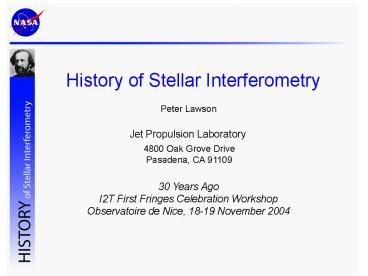History of Stellar Interferometry - PowerPoint PPT Presentation
1 / 30
Title: History of Stellar Interferometry
1
History of Stellar Interferometry
Peter Lawson 30 Years Ago I2T First Fringes
Celebration Workshop Observatoire de Nice, 18-19
November 2004
Jet Propulsion Laboratory
4800 Oak Grove Drive Pasadena, CA 91109
2
On Tides, Organ Pipes, and Soap Bubbles
- Tides at Batsha (1684)
- Newtons Principia (1688)
- Thomas Young (1773-1829) and uncle Brocklesby
- General Law of interference
- Two slit experiment (1802)
3
Armand Hippolyte Fizeau (1819-1896)
- 1845 Fizeau and Foucault describe fringes in
dispersed light
4
Fizeau Suggests Stellar Interferometry 1867
5
Edouard Stephan (1837-1923)
- 1874 E. Stephan uses the Foucault refractor at
the Marseilles Observatory to observe most stars
down to 4th magnitude. - 65 cm aperture separation.
- All stars produce distinct fringes.
- Concludes stars must have diameters much smaller
than 0.158 arcseconds.
6
Foucault Refractor
7
Albert A. Michelson (1852-1931)
- 1878. Measures speed of light 200 times more
accurately than previous measurements. - 1880. Invents Interferential Refractometer in
Berlin while on leave from Naval Academy. - 1887. Michelson-Morley experiment.
- 1890. Describes mathematical basis of stellar
interferometry - and proposes an approach to long-baseline
optical interferometry
8
On the Application of Interference Methods to
Astronomy (1890)
9
Moons of Jupiter (1891)
10
Other Applications in 19th Century
- First use of interferometry to measure binary
stars (1895)
- 1896 M. Hamy performs aperture masking
measurements at the Observatoire de Paris,
repeating work by Michelson
11
Timeline of Interferometry to 1938
12
30 years goes by
- Michelsons measurements of the Moons of Jupiter
was a feasibility test. Why didnt he follow it
up? - Work had been planned with the 32-inch at Lick,
but Michelson left for Europe. - He never followed up with the observations at
Lick - Perhaps there was no point. Stars were obviously
too small to measure with single telescopes - stellar interferometry was only a footnote in
Michelsons extremely productive career - Depression in Chicago in 1890s (little money)
- World War I
13
Mount Wilson Observatory
- 1914 Russell proposes two classes of red stars
- 1919 Michelson funded to measure diameters
- Much confusion over predicted sizes of stars
- 25 ft rotatable interferometer proposed to George
Elliot Hale
14
Michelsons 20 ft Interferometer
Continuation of work left off in 1891, based on
an idea published in 1890
Stellar diameter estimated at baseline where
fringes vanish
15
First Fringes 13 December 1920
16
Was Michelson Influenced by Fizeau?
- Yes
- No
17
Work Continues in the 1920s and 30s
- Observations of Betelgeuse and other stars in
1921 - A small number of other targets observed in the
1920s - Francis Pease plans a more ambitious instrument
- Michelson dies in 1931
18
50 ft Interferometer (1931-1938)
19
Light Paths in the 50 ft Interferometer
20
Ground-level at the 50 ft
21
F.G. Pease (1881-1938)
- Designed and built by F.G. Pease (1931).
- Probably subject to numerous problems
- 38 cm mirrors produced speckled images
- Increased fringe motion at longer baselines
- Excessive vibrations
- Polarization mismatch between arms
- Produced results of questionable value
- Accuracies estimated at 10 - 20
- Observations ceased in 1938
- at the limits of technology
22
Timeline of Optical Interferometry to 1970
- Radio astronomy born in 1932
- World War II creates a generation of radar
engineers
- Radio interferometry developed in 1950s
- Earth-rotation aperture synthesis developed 1960
23
A New Type of Stellar Interferometer (1956)
- R. Hanbury Brown and R.Q. Twiss (1956).
- Diameter of Sirius estimated from experiments at
Jodrell Bank, UK (1956).
24
Intensity Interferometer (1963-1976)
- Manchester University and Sydney University build
the Intensity Interferometer at Narrabri, NSW,
Australia (starting 1961) - Initially under the guidance of Twiss
- Hanbury Brown established as Professor at Sydney
University
25
Intensity Interferometer (1963-1976)
- Measures 32 stars to a limiting magnitude of
B2.5, spectral types O-A inclusive, and
accuracies of 1 or 2. - Measures orbit of Spica (a Vir)
26
Robert Hanbury Brown
27
Interest in Optical Interferometry in the 1960s
- W.I. Beavers , Modern Stellar Interferometry
Astron. J. 68 (1963) - R.H. Miller, Measurement of Stellar Diameters
Science 153 (1966) - 1967 Woods Hole Summer Study on Synthetic
Aperture Optics - Advisory Committee to the Air
Force Systems Command - Closure phase proposed by Rogstad for optical
arrays - D. Currie and the University of Maryland (1967)
- H.A. Gebbie, R.Q. Twiss, W.J. Tango and the
Monteporzio Interferometer - Goodman proposes aperture masking imaging with
closure phase information - E.S. Kulagin, Pulkovo Observatory, measures
Capella 1970
28
Interferometry in the Early 1970s
- Speckle interferometry invented 1970
- Lunar occultation measurements ongoing
- 10 micron heterodyne demonstrated by J. Gay at
the Observatoire de Paris 1972. - Amplitude Interferometer (aperture masking) by
Currie et al. June-December 1972 - First long-baseline observations at 10 microns by
Johnson et al. (1974) at MacMath Solar
Observatory using the planet Mercury - Observations in late July and Early August 1974
29
A New Frontier is Opened up in 1974
30
Acknowledgements
- This work was carried out at the Jet Propulsion
Laboratory, California Institute of Technology,
under contract with the National Aeronautics and
Space Administration.































